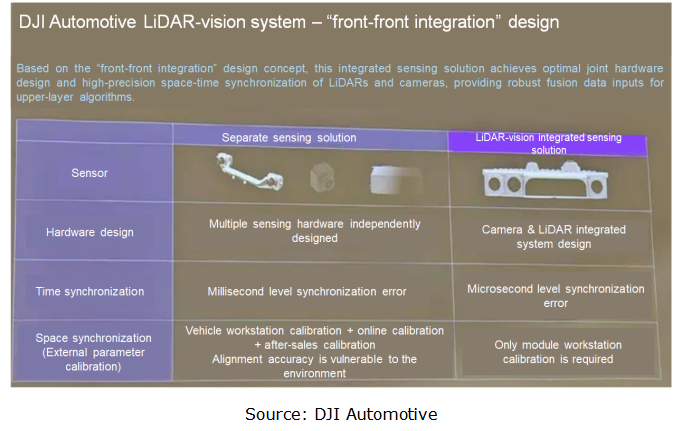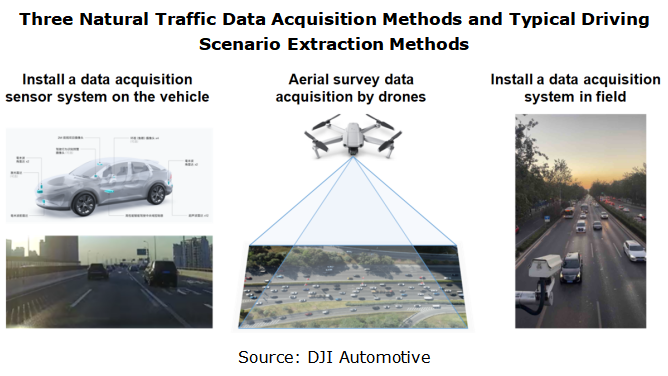Research on DJI Automotive: lead the NOA market by virtue of unique technology route.
In 2016, DJI Automotive’s internal technicians installed a set of stereo sensors + vision fusion positioning system into a car and made it run successfully. DJI Automotive's technologies such as perception, positioning, decision and planning accumulated in the drone field have been successfully transferred to intelligent driving field.?
Almost all founding and management team members of DJI Automotive came from DJI’s drone projects. DJI Automotive had only about 10 members at the beginning, mainly composed of representatives temporarily transferred from the Flight Control Department and Vision Department of DJI at that time.?
?
DJI claims that it is a company specializing in the research of intelligent robots, and drones and autonomous vehicles are different forms of intelligent robots. Relying on its unique technology route, DJI holds lead in the mass production and application of NOA. By DJI Automotive’s estimates, around 2 million passenger cars taking to road will be equipped with DJI Automotive’s intelligent driving systems in 2025.?
Continuously optimize stereo vision sensors
One of the core technologies of DJI Automotive is stereo vision. Even when other sensors like GPS fail, based on visual perception of the stereo camera, drones can still enable hovering, obstacle avoidance, and speed measurement among others.?
After applying stereo vision technology to autonomous vehicles, DJI Automotive continues to optimize stereo vision sensors according to requirements of different autonomous driving levels.
In 2023, to meet the needs of NOA, DJI Automotive launched the second-generation inertial navigation stereo vision system, which eliminates the overall lens hood by adding a customized optical polarizer and cancels the rigid connecting rod using a better self-calibration algorithm. This makes it easier to install the sensor, and the distance between two cameras can be flexibly configured from 180 mm to 400 mm. Elimination of the rigid connecting rod is a huge progress in stereo vision sensors, allowing stereo cameras to be applied in much more scenarios.

Based on the needs of L3 autonomous driving, in 2024 DJI Automotive introduced a LiDAR-vision system, which combines LiDAR, stereo sensor, long-focus mono camera and inertial navigation. Compared with the currently common "LiDAR + front camera" solution on the market, the system can reduce the costs by 30% to 40%, while enabling 100% performance and replacing all the functions. Thanks to the integrated design, the "LiDAR-vision" solution can also be built into the cabin as a whole, reducing the overall installation costs.????
 ???
???
The "LiDAR-vision" solution can further enhance safety in vehicle longitudinal control. Thanks to LiDAR's precise ranging capabilities and robustness to illumination, the "LiDAR-vision" solution can further improve safety and comfort of intelligent driving system in such scenarios as cut-in at close range, complex traffic flow in urban areas, response to vulnerable road users (VRU), arbitrary obstacle avoidance, detour, and VRU at night.
Use drone technologies for data acquisition and simulation
Among the three autonomous driving data acquisition methods, acquisition by vehicles is the most common, but the proportion of effective data is low, and it is easy to interfere with real behaviors of surrounding vehicles, and it is unable to record data in blind spots of sensors. Another method is acquisition in field, with low flexibility and insufficient reliability, a result of angle skew and low image accuracy.????
 ?
?
According to the in-depth research by fka, the automotive technology research institute of RWTH Aachen University, and DJI Automotive's own practices in the past two years, aerial survey data acquisition by drones has obvious advantages. Drones can collect richer and more complete scenario data, and can directly collect aerial objective shots of all vehicles in blind spots of the target vehicle without obstruction, reflecting more realistic and interference-free human driving behaviors, and more efficiently collecting data in specific road sections and special driving scenarios, for example, on/off-ramps and frequent cut-ins.???
Why does the implementation of vision-only autonomous driving suddenly accelerate?
Why has the pace of implementing vision-only technology solutions suddenly quicken since 2024? The answer is foundation models. The research shows that a truly autonomous driving system needs at least about 17 billion kilometers of road verification before being production-ready. The reason is that even if the existing technology can handle more than 95% of common driving scenarios, problems may still occur in the remaining 5% corner cases.??
Generally, learning a new corner case requires collecting more than 10,000 samples, and the entire cycle is more than 2 weeks. Even if a team has 100 autonomous vehicles conducting road tests 24 hours a day, the time required to accumulate data is measured in "hundred years" - which is obviously unrealistic.
Foundation models are used to quickly restore real scenarios and generate corner cases in various complex scenarios for model training. Foundation models (such as Pangu model) can shorten the closed-loop cycle of autonomous driving corner cases from more than two weeks to two days.
Currently, DJI Automotive, Baidu, PhiGent Robotics, GAC, Tesla and Megvii among others have launched their vision-only autonomous driving solutions. This weekly report summarizes and analyzes vision-only autonomous driving routes.
Automotive Radio Frequency System-on-Chip (RF SoC) and Module Research Report, 2025
Automotive RF SoC Research: The Pace of Introducing "Nerve Endings" such as UWB, NTN Satellite Communication, NearLink, and WIFI into Intelligent Vehicles Quickens
RF SoC (Radio Frequency Syst...
Automotive Power Management ICs and Signal Chain Chips Industry Research Report, 2025
Analog chips are used to process continuous analog signals from the natural world, such as light, sound, electricity/magnetism, position/speed/acceleration, and temperature. They are mainly composed o...
Global and China Electronic Rearview Mirror Industry Report, 2025
Based on the installation location, electronic rearview mirrors can be divided into electronic interior rearview mirrors (i.e., streaming media rearview mirrors) and electronic exterior rearview mirro...
Intelligent Cockpit Tier 1 Supplier Research Report, 2025 (Chinese Companies)
Intelligent Cockpit Tier1 Suppliers Research: Emerging AI Cockpit Products Fuel Layout of Full-Scenario Cockpit Ecosystem
This report mainly analyzes the current layout, innovative products, and deve...
Next-generation Central and Zonal Communication Network Topology and Chip Industry Research Report, 2025
The automotive E/E architecture is evolving towards a "central computing + zonal control" architecture, where the central computing platform is responsible for high-computing-power tasks, and zonal co...
Vehicle-road-cloud Integration and C-V2X Industry Research Report, 2025
Vehicle-side C-V2X Application Scenarios: Transition from R16 to R17, Providing a Communication Base for High-level Autonomous Driving, with the C-V2X On-board Explosion Period Approaching
In 2024, t...
Intelligent Cockpit Patent Analysis Report, 2025
Patent Trend: Three Major Directions of Intelligent Cockpits in 2025
This report explores the development trends of cutting-edge intelligent cockpits from the perspective of patents. The research sco...
Smart Car Information Security (Cybersecurity and Data Security) Research Report, 2025
Research on Automotive Information Security: AI Fusion Intelligent Protection and Ecological Collaboration Ensure Cybersecurity and Data Security
At present, what are the security risks faced by inte...
New Energy Vehicle 800-1000V High-Voltage Architecture and Supply Chain Research Report, 2025
Research on 800-1000V Architecture: to be installed in over 7 million vehicles in 2030, marking the arrival of the era of full-domain high voltage and megawatt supercharging.
In 2025, the 800-1000V h...
Foreign Tier 1 ADAS Suppliers Industry Research Report 2025
Research on Overseas Tier 1 ADAS Suppliers: Three Paths for Foreign Enterprises to Transfer to NOA
Foreign Tier 1 ADAS suppliers are obviously lagging behind in the field of NOA.
In 2024, Aptiv (2.6...
VLA Large Model Applications in Automotive and Robotics Research Report, 2025
ResearchInChina releases "VLA Large Model Applications in Automotive and Robotics Research Report, 2025": The report summarizes and analyzes the technical origin, development stages, application cases...
OEMs’ Next-generation In-vehicle Infotainment (IVI) System Trends Report, 2025
ResearchInChina releases the "OEMs’ Next-generation In-vehicle Infotainment (IVI) System Trends Report, 2025", which sorts out iterative development context of mainstream automakers in terms of infota...
Autonomous Driving SoC Research Report, 2025
High-level intelligent driving penetration continues to increase, with large-scale upgrading of intelligent driving SoC in 2025
In 2024, the total sales volume of domestic passenger cars in China was...
China Passenger Car HUD Industry Report, 2025
ResearchInChina released the "China Passenger Car HUD Industry Report, 2025", which sorts out the HUD installation situation, the dynamics of upstream, midstream and downstream manufacturers in the HU...
ADAS and Autonomous Driving Tier 1 Suppliers Research Report, 2025 – Chinese Companies
ADAS and Autonomous Driving Tier 1 Suppliers Research Report, 2025 – Chinese Companies
Research on Domestic ADAS Tier 1 Suppliers: Seven Development Trends in the Era of Assisted Driving 2.0
In the ...
Automotive ADAS Camera Report, 2025
①In terms of the amount of installed data, installations of side-view cameras maintain a growth rate of over 90%From January to May 2025, ADAS cameras (statistical scope: front-view, side-view, surrou...
Body (Zone) Domain Controller and Chip Industry Research Report,2025
Body (Zone) Domain Research: ZCU Installation Exceeds 2 Million Units, Evolving Towards a "Plug-and-Play" Modular Platform
The body (zone) domain covers BCM (Body Control Module), BDC (Body Dom...
Automotive Cockpit Domain Controller Research Report, 2025
Cockpit domain controller research: three cockpit domain controller architectures for AI Three layout solutions for cockpit domain controllers for deep AI empowerment
As intelligent cockpit tran...